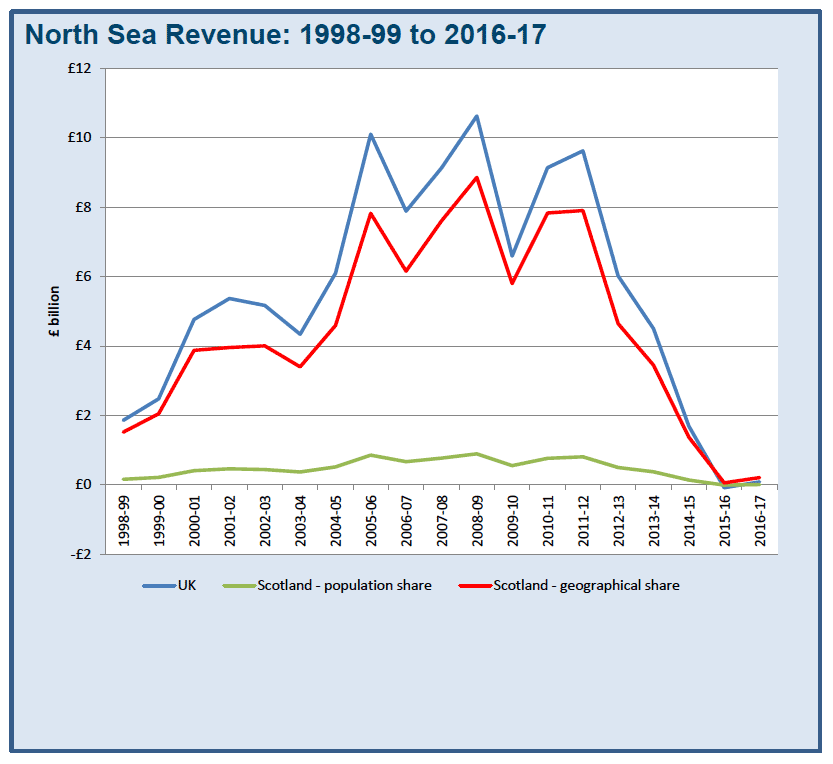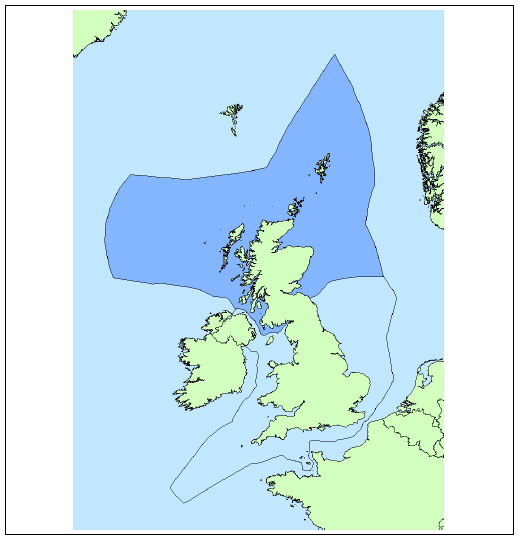Government Expenditure and Revenue Scotland 2016-2017
National Statistics publication estimating the contribution of revenue raised in Scotland towards goods and services provided in Scotland.
Chapter 2: North Sea Revenue

Introduction
In GERS, the term North Sea is used to refer to all offshore oil and gas activity. North Sea revenue in GERS comes from three sources: petroleum revenue tax, corporation tax, and licence fees.
In February 2017, the ONS changed the reporting of corporation tax to move to an accruals basis. This change aims to better reflect the time at which the economic activity relating to the tax receipts took place, in accordance with the principles of the European System of National Accounts ( ESA 2010). Following a public consultation, this change has also been made to the reporting of North Sea revenue in GERS. This change applies from 2000-01 onwards. The main impact of the change is to shift revenue between years, smoothing the profile of revenue. Although there are some larger changes in individual years, overall as a result of the change total North Sea corporation tax revenue between 2000-01 and 2016-17 has been revised by around £100m, or 0.1%. The changes are discussed in more detail in a methodology note available on the ONS website. [18]
Table 2.1 shows the revenue raised from each component of North Sea revenue since 2012‑13. UK North Sea revenue was £6.0 billion in 2012-13, but has declined since, due to lower production, rising expenditure, and, since 2014-15, lower oil prices. UK North Sea revenue was £84 million in 2016-17. In order to align the presentation of revenue with that used by the OBR, revenue from the emissions trading scheme is no longer presented here, but is now included in the 'other taxes' line.
Table 2.1: Composition of North Sea Revenue: UK 2012-13 to 2016-17
| £ million | |||||
|---|---|---|---|---|---|
| 2012-13 | 2013-14 | 2014-15 | 2015-16 | 2016-17 | |
| Licence fees | 69 | 71 | 70 | 72 | 72 |
| North Sea corporation tax | 4,214 | 3,310 | 1,544 | 410 | 661 |
| Petroleum revenue tax | 1,737 | 1,118 | 77 | -562 | -649 |
| Total | 6,020 | 4,499 | 1,691 | -80 | 84 |
North Sea revenue is subject to annual fluctuations and is driven by a number of factors, including the oil price, the sterling dollar exchange rate, production, operating expenditure, capital investment, and the prevailing fiscal regime. Most of these factors have been acting to reduce revenue in recent years, with lower oil prices in particular having an impact.
During 2016-17, the oil price averaged $48.5. This represents a slight increase from $47.3 in the previous year but is still significantly lower than its level in 2013-14 ($107.6). [19] However, as most North Sea operators sell their oil in dollars, the decline in the sterling dollar exchange rate, which was on average 12% lower in 2016-17 compared to 2015-16 will have provided a boost to the sterling value of their production. [20]
North Sea production remained broadly stable in 2016-17 compared to 2015-16, with gas production up 2% [21] while crude oil and natural gas liquid production fell by 0.6%. [22] This followed increases in production in 2015-16.
In 2016 total expenditure on the UK continental shelf continued to fall, reducing a further 19% compared to 2015. This was primarily due to lower investment, which fell by 26%, but there were also falls in operating costs and exploration expenditure. In contrast, there was an increase in decommissioning expenditure, which rose by 34% to £1.2 billion, although remained below its 2014 peak of £1.7 billion. [23]
Significant changes were made to the fiscal regime in the March 2015 and 2016 Budgets, including the Supplementary Charge being halved to 10%, and Petroleum Revenue Tax ( PRT) progressively being reduced from 50% to 0%.
As shown in Table 2.1, PRT receipts are now negative. This reflects the fact that, although companies no longer pay PRT, they can still claim refunds on PRT paid in previous years against current trading losses and decommissioning spending. As a result PRT receipts will only be negative in the future under the current tax regime.
Scotland's Share of North Sea Revenue
In the ONS Regional Accounts, the UK continental shelf is included as a separate region of the UK (the extra-regio territory) and not allocated to specific geographic regions within the UK mainland. As such, an assumption as to Scotland's share of the North Sea needs to be made in GERS.
Three estimates of Scotland's share of North Sea revenue are shown in GERS:
1. A zero share
2. A population share
3. An illustrative geographical share
The discussion below focuses on population and geographical shares.
Population Share
One interpretation of North Sea revenue is to view it as a non-identifiable UK revenue, in which case a population share may be apportioned to Scotland. Table 2.2 provides an estimate of Scotland's share of North Sea revenue under this approach.
Table 2.2: Population Share of North Sea Revenue: Scotland 2012-13 to 2016-17
| £ million | |||||
|---|---|---|---|---|---|
| 2012-13 | 2013-14 | 2014-15 | 2015-16 | 2016-17 | |
| Total North Sea revenue | 6,020 | 4,499 | 1,691 | -80 | 84 |
| Scotland's population share | 502 | 374 | 140 | -7 | 7 |
| Scotland's share of North Sea revenue (%) | 8.3% | 8.3% | 8.3% | 8.2% | 8.2% |
An Illustrative Geographical Share
An alternative approach is to apportion a geographical share of North Sea revenue to Scotland. In order to estimate this share, GERS uses the share reported in the ONS Country and Regional Public Sector Finances publication. This is a change from previous years' methodology, which drew upon academic research carried out by Professor Alex Kemp and Linda Stephen from the University of Aberdeen.
The methodological change follows a recommendation from the UK Statistics Authority report on GERS to review and reduce the differences between the GERS and HMRC estimates. Following this recommendation, the Scottish Government and HMRC have been working to compare their estimates across a range of variables such as production of crude oil, non-gaseous liquids, and natural gas; sales revenue; operating expenditure; and capital and decommissioning expenditure. Professor Alex Kemp has also been involved in this process. As well as comparing the results from the two models, the Scottish Government has produced its own estimates of Scotland's share of North Sea revenue. This has built upon the work estimating oil and gas production, income, and expenditure published as part of the Scottish National Accounts Project.
As a result of this work, a number of differences have been identified between the models. Firstly, the estimates use different data, with HMRC analysis based on administrative tax data and Professor Kemp's based on self-reported company data. The main modelling difference relates to the level at which tax liability is estimated. Professor Alex Kemp estimates the tax liability at the field level, whilst HMRC and the Scottish Government estimate the tax liability at company level. Other differences between the models, such as differences between prices, were found to have little impact on the overall tax share. From an analytical perspective, estimating corporation tax liabilities at the company level more closely reflects the reality of how the tax is paid. Using the HMRC data for PRT also reduces the need for estimation, as this tax is now based entirely on administrative data.
Following this work, the changes were consulted on with the Scottish Economic Statistics Consultation Group ( SESCG) and also through a public consultation. Both were supportive of the change. Further details of the changes, including comparisons of the different model outputs, is provided in the GERS Consultation documents. [24]
The estimate continues to be based on the median line principle as employed in 1999 to determine the boundary between Scotland and the rest of the UK for fishery demarcation purposes. Other alternatives are possible. Production, costs and revenue are allocated on a field by field basis to either the rest of the UK or Scotland using this boundary.
One impact of the methodological change is the ability to provide a greater disaggregation of North Sea revenues, which previously were estimated as a single block. Table 2.3 shows Scotland's illustrative geographical share of UK North Sea revenue, broken down by licence fees, corporation tax, and petroleum revenue tax. In 2015-16 and 2016-17, Scotland's illustrative geographical North Sea revenues are estimated to be higher than the UK total. This reflects the fact that the Scotland's share of petroleum revenue tax, which is currently negative, is lower than its share of corporation tax.
Table 2.3: Geographical Share of North Sea Revenue: Scotland 2012-13 to 2016-17
| £ million | |||||
|---|---|---|---|---|---|
| 2012-13 | 2013-14 | 2014-15 | 2015-16 | 2016-17 | |
| UK revenue | 6,020 | 4,499 | 1,691 | -80 | 84 |
| Licence fees | 69 | 71 | 70 | 72 | 72 |
| North Sea corporation tax | 4,214 | 3,310 | 1,544 | 410 | 661 |
| Petroleum revenue tax | 1,737 | 1,118 | 77 | -562 | -649 |
| Scottish geographical revenue | 4,643 | 3,448 | 1,374 | 56 | 208 |
| Licence fees | 57 | 58 | 58 | 59 | 59 |
| North Sea corporation tax | 3,485 | 2,718 | 1,269 | 335 | 540 |
| Petroleum revenue tax | 1,101 | 672 | 47 | -338 | -390 |
| Scottish share of UK | 77.1% | 76.6% | 81.3% | -69.6% | 247.9% |
| Licence fees | 82.7% | 82.1% | 82.2% | 81.6% | 81.6% |
| North Sea corporation tax | 82.7% | 82.1% | 82.2% | 81.7% | 81.6% |
| Petroleum revenue tax | 63.4% | 60.1% | 61.3% | 60.1% | 60.1% |
Scotland's estimated geographical share of the North Sea sector, used in this report, is highlighted in the figure below.
UK Continental Shelf and Scottish Boundary

Source: Marine Scotland
Contact
Email: Sandy Stewart, economic.statistics@gov.scot
Phone: 0300 244 4000 – Central Enquiry Unit
The Scottish Government
St Andrew's House
Regent Road
Edinburgh
EH1 3DG
There is a problem
Thanks for your feedback